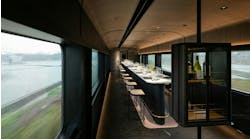Change is in the indoor air for the Leadership in Energy and Environmental Design (LEED) Rating System. IEQ Credit 4 (IEQc4), which is intended to improve indoor air quality through the use of low-emitting products, is poised to undergo a major language makeover that, if fully realized, could hurt the indoor air quality of green buildings—including schools—instead of helping.
In short, the proposed revisions to IEQc4—known as Pilot Credit 21: Low-Emitting Interiors—don't sufficiently protect building occupants from indoor air pollution caused by product emissions. Instead, Pilot Credit 21 encourages adherence to weak product emissions criteria and insufficient test methods, according to the indoor air quality experts at the GREENGUARD Environmental Institute.
"It's disconcerting, really," says Henning Bloech, GREENGUARD's executive director. "The intent of the original IEQc4 has always been to safeguard against poor indoor environmental quality. If the LEED committee is going to change the credit, why not strengthen it to allow for more robust protection of human health? It seems they're doing just the opposite here."
Bloech points out that Pilot Credit 21 all but ignores concerns raised in last year's report, "LEED Certification: Where Energy Efficiency Collides with Human Health" by Environment and Human Health, Inc. (EHHI). The report highlighted the indoor air quality problems that some LEED-certified buildings have experienced as a result of builders' and end-users' use of high-emitting products during construction, build-out and furnishing.
In response to these proposed changes, the GREENGUARD Environmental Institute launched a campaign in November 2010 to educate the public about the health risks associated with Pilot Credit 21. GREENGUARD cites the following concerns with the proposed credit language.
Concern No. 1: Product emissions
As currently written, Pilot Credit 21 sets emission limits on only 35 compounds—those identified by California as having "Chronic Reference Exposure Limits," or CRELs. Unfortunately, there are hundreds, if not thousands, of other potentially toxic compounds and complex mixtures without CRELs that can off-gas from products and compromise building occupants' health and well-being.
"Just because a particular chemical does not have a CREL, it does not mean that the chemical is safe," says Dr. Marilyn Black, founder of the GREENGUARD Environmental Institute. "It simply means that a CREL hasn't been developed for that chemical yet. As a matter of fact, 90 percent of volatile organic compounds (VOCs) that emit from products don't have CRELs, so when you look at it that way, Pilot Credit 21 doesn't even address—let alone fulfill—its intent. It creates a false sense of security that the indoor air quality of a building is good."
Additionally, Black points out that Pilot Credit 21 does not address (with the exception of furniture) the total level of all VOCs combined, known as total volatile organic compounds, or TVOC. A cap on TVOC acts as a safeguard against the hundreds of chemicals whose health impacts are not yet known—including any new compounds that form when individual chemicals combine, or synergize.
Paradoxically, the LEED rating system awards points for meeting a TVOC level during a building pre-occupancy clearance test. The problem is that if the only products screened for TVOC are furniture, the multitude of other products in the building may push the TVOC limit over the threshold, resulting in buildings that are unable to meet the LEED TVOC requirements in the clearance test.
"How is a specifier supposed to find low-emitting products that help create healthy spaces and meet the LEED TVOC criteria for building clearance testing if the vast majority of products aren't evaluated for TVOC?" Black says.
Concern No. 2: Too much complexity
In addition to weak product emissions requirements, Pilot Credit 21 adds a new layer of complexity to the LEED rating system that is so confusing, it will likely discourage project teams from pursuing the credit altogether. The credit will now require architects, designers and specifiers to review complex laboratory reports and emissions test data, and determine on their own if a product will qualify for the credit. This could lead to users skipping the credit altogether or misinterpreting a lab report. Either way, the overall indoor air quality of LEED-certified buildings will be compromised.
"As a sustainable design consultant and a LEED Accredited Professional for 10 years, even I have a hard time trying to decipher what it all means," says Penny Bonda, fellow of the American Society of Interior Designers. "There are so many complex calculations and multiple requirements for multiple product types that I'm afraid most people just won't bother with it. And since indoor air quality is such a critical ingredient to sustainable design, that's definitely not what we want to have happen."
Concern No. 3: Differing emissions requirements
The credit language revisions apply to the LEED family of international standards, and as currently drafted, Pilot Credit 21 allows products in North America to meet different indoor air quality criteria than products in the rest of the world. In North America, CA 01350 would be used; everywhere else, Germany's AgBB Testing and Evaluation, along with ISO 16000-11, would be used.
Since the criteria of AgBB are arguably more stringent than those of CA 01350 (AgBB requires both a TVOC limit and emission limits on more than 175 compounds, as opposed to just 35), LEED-certified buildings in North America could potentially have worse indoor air quality than those constructed outside of North America.
Furthermore, Pilot Credit 21 references an entirely different test method for furniture—one that allows manufacturers to cherry-pick from among six different compliance paths. This lack of consistency may lead to less stringent emission limits and, subsequently, compromised indoor air quality in LEED-certified buildings. In fact, some furniture products would be allowed to emit 50 percent more chemicals than what was allowed in the previous version of LEED.
Finally, where one industry test method was added to Pilot Credit 21, another was dropped—to the detriment of indoor air quality. The Carpet and Rug Institute's (CRI) GREEN Label Plus program was eliminated from the revised LEED credit language in favor of CA 01350. As a result, carpet-specific chemicals like 4-phenylcyclohexene, which is largely responsible for the "new carpet smell," will no longer be controlled. The GREEN Label Plus program has been extremely effective in controlling carpet-specific chemicals, but its removal from the revised LEED rating system will likely lead to indoor air contamination.
Concern No. 4: Poorly defined emissions criteria
Poorly defined and inconsistent product emissions criteria and test methods within Pilot Credit 21 will result in varying levels of product emissions. For example (as previously noted), a TVOC option exists for furniture but not for any other products. Similarly, office furniture is allowed to be tested differently than all other products, which is problematic because hundreds of other products and materials are also installed and used in an office environment.
Additionally, composite wood products, such as cabinetry, flooring and architectural woodwork, are required to comply only with a formaldehyde emissions limit (one that just so happens to be weaker than what's allowed for other product types, too) rather than emission limits on all chemicals.
Finally, the prescribed emissions criteria for furniture are applicable only to office environments—not to schools, healthcare facilities or other types of buildings. This means that some LEED-certified buildings will receive points for using furniture that might not have been tested for use in the appropriate setting. This is an important distinction, as different buildings have different properties, such as room size and ventilation rates. Architects and designers will likely not be aware of this discrepancy in testing, which again will lead to compromised indoor air quality in LEED-certified buildings.
Concern No. 5: Pre-approval of standards that are not yet developed
Pilot Credit 21 asks stakeholders to approve consensus-based standards that are either still in the development process or are yet to be drafted. Since consensus-based standards are, by their very nature, a work-in-progress until all participating parties have come to an agreement, it is impossible to know what the final standards will look like—and it is therefore unreasonable to ask for their approval until they are finalized.
"That's one issue," says Black. "The other issue is that 'consensus-based' standards are not necessarily scientifically sound or protective of human health. In fact, they're often weaker in some respects because so many parties with varying agendas weigh in and shape the development of the standards to suit their own needs."
How to help clear the air
Pilot Credit 21 is slated to undergo a second round of public comments in mid to late summer 2011 (the first comment period closed in January). During this time, architects, designers and stakeholders from all walks of life are encouraged to submit their comments and suggestions to the U.S. Green Building Council (USGBC).
"We have to remember that green building is so much more than just energy efficiency, water conservation and waste reduction. It's about sustaining the health of the people who occupy the buildings," Bloech says. "We must continue upping the ante when it comes to healthy indoor environments. Strengthening Pilot Credit 21 can help do that."
For more information, visit www.greenguard.org/pledge.

